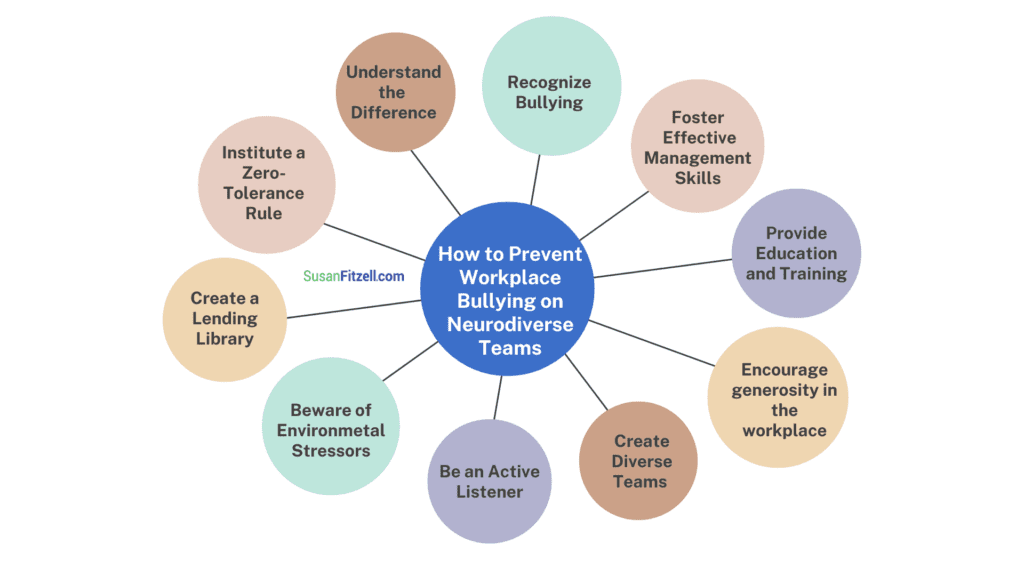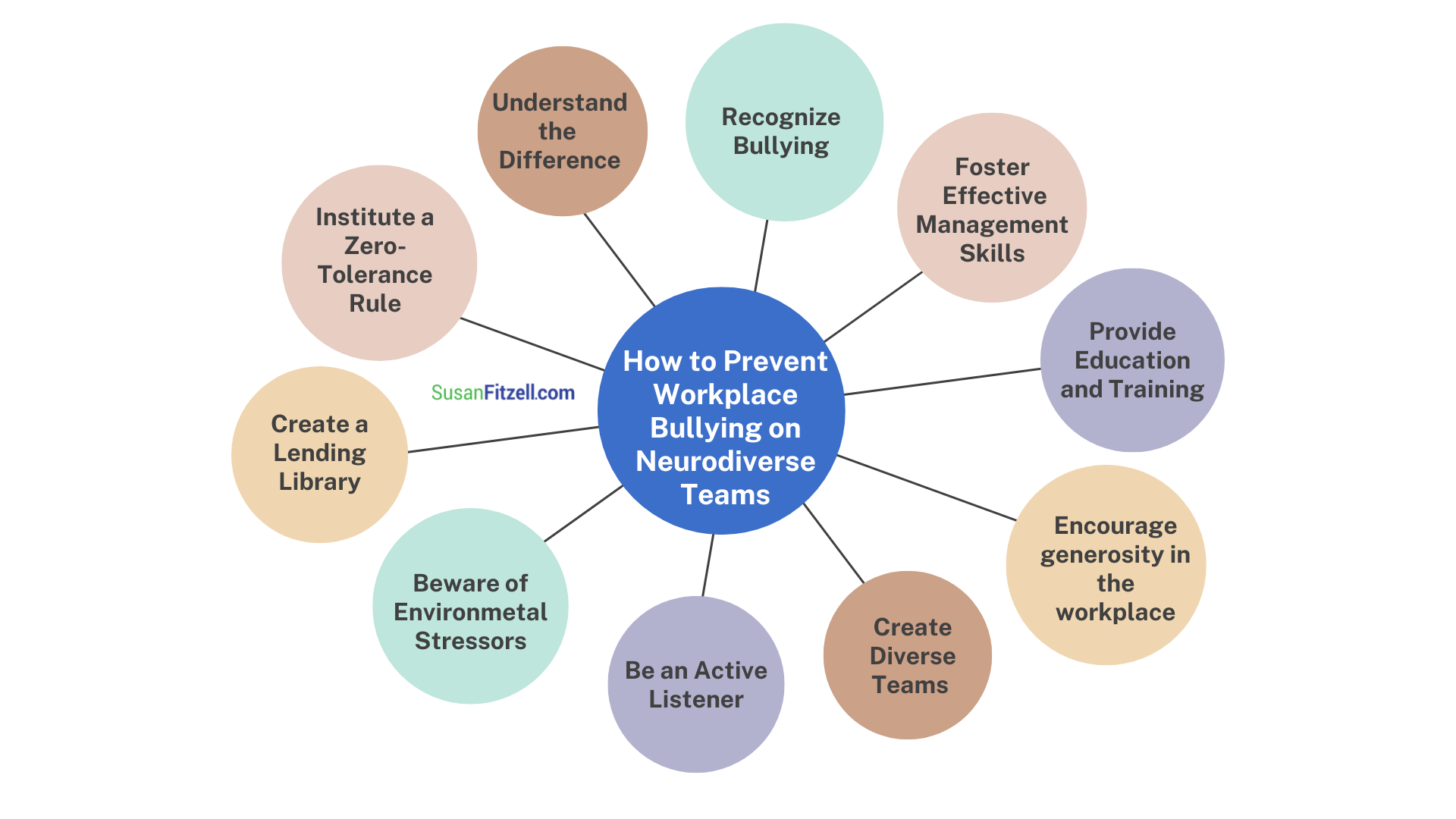By Susan Fitzell, M.Ed., CSP

Workplace bullying is a severe issue for all employees, and it is exponentially destructive for people on the autistic spectrum or with other neurocognitive differences. We know bullying, hazing, and harassment are workplace problems. Many of us struggle with how to deal with the issue effectively to s. Rather than philosophize about this issue, I’m sharing some practical strategies that provide ALL employees with a psychologically safe workplace and prevent bullying in a neurodiversity initiative.
1. Recognize bullying
Many workplaces do not recognize most bullying as severe enough to take action. Non-action conveys that the behavior is acceptable in a company’s culture. Consequently, bullying continues unchecked. Recognizing bullying is, therefore, crucial. We can’t fix a problem we can’t (or refuse to) see. Some companies face lawsuits because their neurodiversity initiative did not prepare the culture to understand and support the initiative first. Without taking the time to lay the groundwork, it’s challenging to build trust and psychological safety for teams.
Watch this video if you’d like to know how to promote trust on neurodiverse teams.
2. Foster effective management skills
“Nothing about us, without us,” an expression that may have originated at a disability conference in Eastern Europe, is an expression passionately exclaimed by the autistic community. Often, people with disabilities, people whose brains are wired differently, or people from minority groups are not included in discussions that make decisions that impact their lives and livelihoods. Influential leaders understand the importance of having stakeholders in the decision-making process. Ask for their thoughts, suggestions, and feedback. Provide a safe space for employees to share what isn’t working or how things might work even better. Success soars when a manager’s engagement with their employees is high. A manager’s attitude toward building a strong, supportive, positive workplace culture plays a vital role in protecting neurodivergent employees from harassment.
3. Provide education and training
Provide training and education about neurodiversity through thoughtful discussions and frequent training sessions. A one-and-done webinar on neurodiversity is not enough. It takes time, effort, and difficult conversations to foster changes in attitudes that, often, have formed over a lifetime. However, the investment is worthwhile because neurotypical employees can better support their neurodivergent coworkers when they understand daily difficulties. For a tangible example, meet Ella, an employee with a non-verbal learning disorder, and consider her humiliation when her teammate didn’t understand her learning differences.
4. Encourage generosity in the workplace
Appreciate employees’ excellent performance, give constructive feedback, and actively listen to their problems. I’ll never forget the one boss I had in my career that took the time to encourage, appreciate, and give kudos to me on sticky notes. That sticky note might be on a returned report he handed me (it said, “A thing of beauty”), or found in my office mailbox (that one said, “Well run meeting”), or on my desk (there were several over the years). I still have them. These little acts of kindness unlock generosity, willingness to share knowledge, and high morale. When employees feel good about their work environment, they are kinder to each other.
5. Create diverse teams when possible
I’ve heard stories of autistic employees being assigned to teams that only included other autistic employees. That’s akin to taking all the kids with learning disabilities and pulling them into a group in the back of the classroom and teaching them separately. The stigma is enormous, and expectations are often lower, thus stunting their growth. The effect is the same in the workplace. Include neurotypical and neurodivergent workers on teams because the ROI is much greater with the cognitive diversity on inclusive teams. Provide an environment that encourages a healthy exchange of ideas and acceptance of human differences. Such an environment helps employees to develop patience, generosity, acceptance, and mindfulness, all known to increase employee loyalty and retention.
6. Be an active listener
Listening skills are seriously underrated. Twenty years ago, active listening skills were taught in schools and businesses regularly. It was a ‘thing.’ Like many passing trends, listening skills fell out of vogue. Then came smartphones and reduced in-person face-to-face interaction. I suspect we, as a human race, listen less today than at any other time in history. Become a dependable source of support for your employees by learning how to connect sincerely and listen. Pay attention. It’s essential to not only listen to the words spoken but also to ‘listen’ to what is unsaid. Actively listen to them and provide helpful feedback. Active listening skills strengthen business connections, foster a sense of being heard or valued, foster trust, and enhance the value of communication. For a step-by-step guide for active listening, see my article, “3 Critical Skills Needed to Advance Your Career.”
7. Beware of environmental stressors
Inadequate or harsh lights, loud sounds, and strong fragrances can cause some, including the neurodivergent, to suffer chronic headaches, anxiety, visual stress, and depression. It’s difficult, and sometimes impossible, to work to the best of your ability in an uncomfortable environment. This is not an attitude problem; this is a biological problem. It’s also not a problem that only applies to neurodivergent employees. Consider how well you’d work in an office that was freezing cold or overly hot. How focused are you if you are trying to work while someone is banging on the ceiling while installing a new roof or fixing the air conditioning unit? Random noises are the worst distractors and annoyances. All of us struggle with some of these things.
Designing an environment conducive to high productivity is a win-win for everyone. If you can spare office space to create a sensory room, it might be just what is needed to bring out the best in some of your employees. For more information on sensory rooms, I’ve expanded on the idea in this article, “Sensory Rooms - Facilitating Neurodivergent- Friendly Workplaces.”
8. Create a lending library
Human resource teams and managers in every neurodiverse organization would benefit from access to books or articles on neurodiversity written by neurodivergent authors. Most people still don’t know what the word “neurodiversity” means. Even fewer understand the deeper nuances of neurodivergence. Making books and resources on neurodiversity available allows people to learn when they are interested and ready. These resources would be better if provided in multiple formats such as audiobooks, white papers, paperbacks, or digitally.
9. Institute a zero-tolerance rule
Bullying occurs in work environments where a disrespectful attitude is accepted. Implement strictly operational policies to stop workplace bullying under all circumstances and foster an atmosphere of mutual respect and courtesy. All allegations of abuse or bullying at work, whether possible or actual, should be dealt with in privacy, addressed seriously, and immediately investigated.
10. Understand the differences
Understand the differences between neurodivergent people born with brains wired differently and other mental disabilities and illnesses. Understand that not all autistic people have high support needs. Many are so successful in their careers and good at masking their neuro difference that they appear neurotypical. Recognizing our neurological perspectives helps us coexist more smoothly. Most of our attitudes and views toward people on the spectrum, or people with dyslexia, OCD, and other types of neurodivergence, are inaccurate. They are based on media representations or that kid we went to school with that was constantly criticized by the teacher for not acting or learning like ‘the other kids.’
Final thoughts on ways to prevent bullying in a neurodiversity initiative
It is time to stop ignorance and intolerance toward neurodivergence. If there is anything for which we need a solution, it is not autism but rather prejudice and ignorance. So, taking steps to understand neurodiversity, talk about it openly, and promote understanding will go a long way to foster successful neurodiversity.
Neurodiversity Definition
Neurodiversity: this term refers to a general diversity of minds. It includes people who are neurotypical and neurodivergent. When I talk about promoting neurodiversity in the workplace, for example, I am referring to creating a diverse workforce representative of the broad spectrum that exists when it comes to ways of thinking, processing information, communication, and learning. Some employees may be “normal” or neurotypical while others may have ADHD, Dyslexia, Autism, or trauma impacted ways of thinking. I am not referring to any particular label or diagnosis, but rather, the concept of an environment where a diversity of minds coexist.
Neurodiverse: This word is pretty much the same as neurodiversity, but should be used as an adjective. You can say, for example, that your workplace is neurodiverse.
Be careful though, because you should never describe a person as being neurodiverse. Individual people should be described as neurodivergent.
Neurodivergent: This word describes an individual whose way of thinking falls outside of society’s defined version of normal. Oftentimes you will see it abbreviated as ND.
Many times, neurodivergent people will have a diagnosis or label you may recognize, like autism, dyslexia, or ADHD. But neurodivergent people are also those with epilepsy, different kinds of brain trauma, or simply a unique way of thinking that may not have a specific diagnosis.
CLICK HERE to visit the articles page.
 FREE DOWNLOAD: Neurodiversity in the Workplace: Things to Consider Before You Jump On the Bandwagon
FREE DOWNLOAD: Neurodiversity in the Workplace: Things to Consider Before You Jump On the Bandwagon
Neurodiverse hiring practices can benefit any company in any industry and in more areas than most people realize. The investment has yielded greater patenting, innovation, process improvement, efficiency, and creativity not only in technology industries but also in industries that include investment banking, insurance, and mortgage banking.
This resource explains the term “neurodiversity” and describes the potential positive impact on your business that can come from including neurodivergent individuals in your workplace.
Download Neurodiversity in the Workplace! – Free!
Bring Susan Fitzell, M.Ed., CSP
Top Neurodiversity Speaker
To YOUR Organization!


